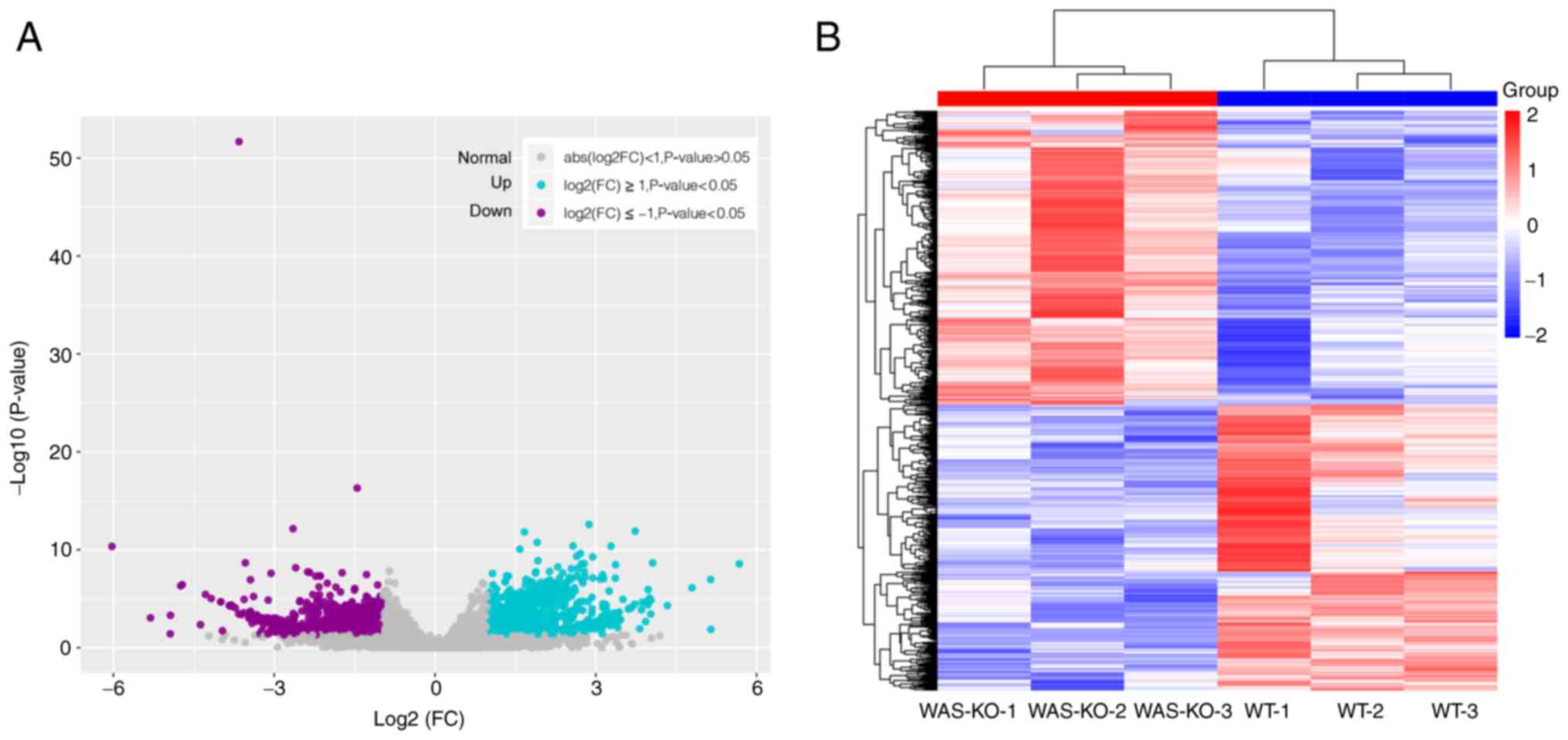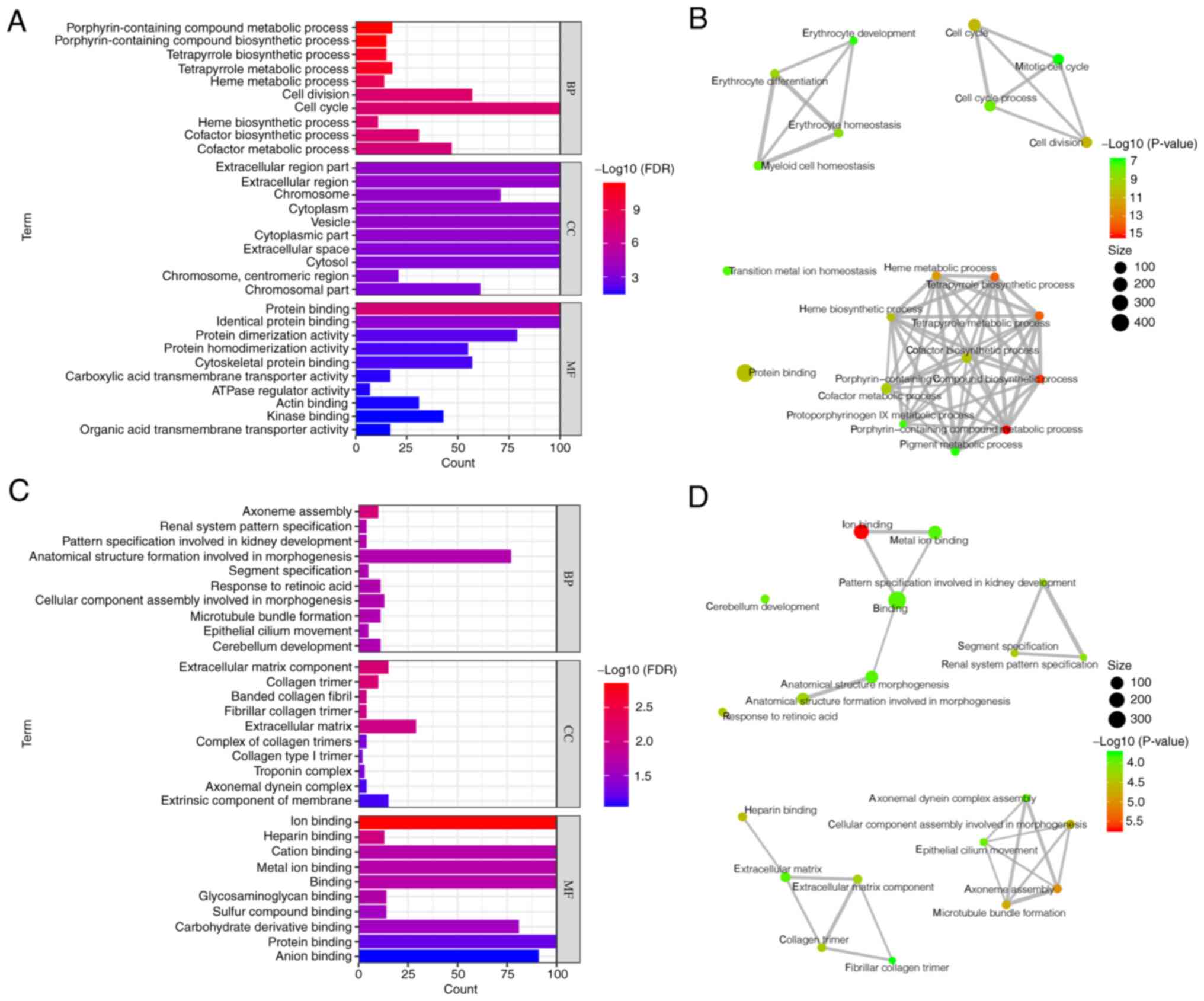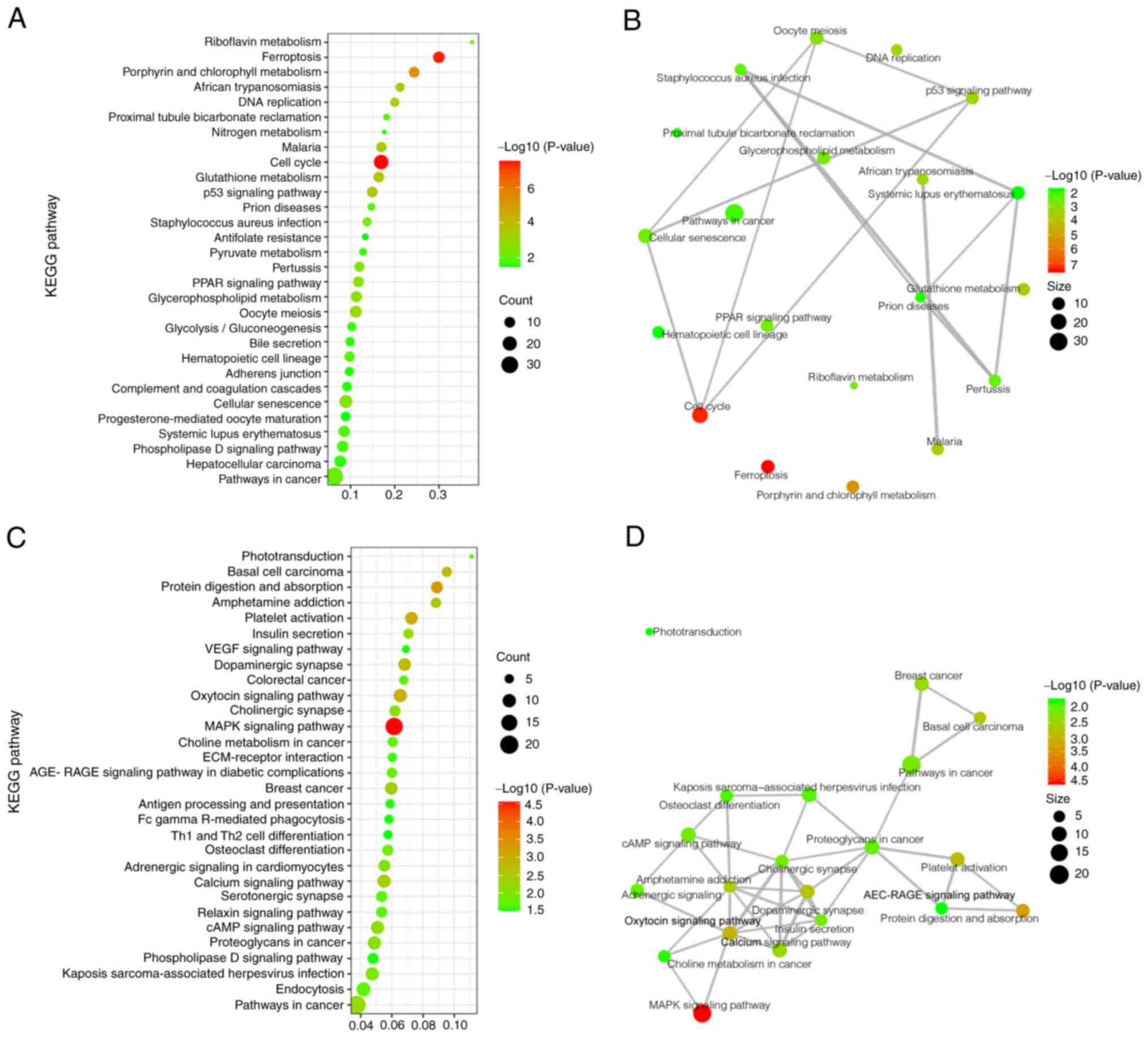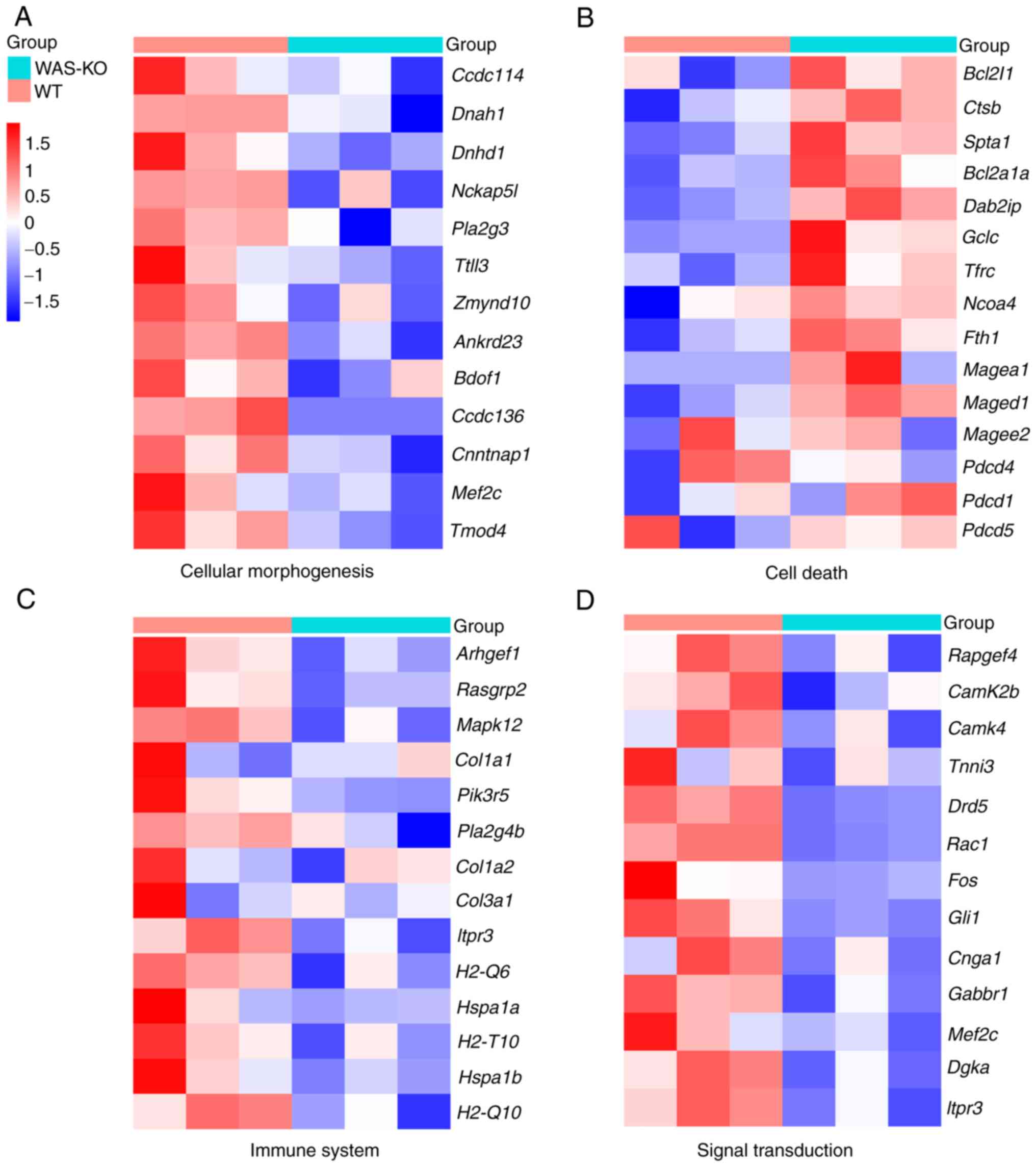|
1
|
Peacocke M and Siminovitch KA:
Wiskott-Aldrich syndrome: New molecular and biochemical insights. J
Am Acad Dermatol. 27:507–519. 1992.PubMed/NCBI View Article : Google Scholar
|
|
2
|
Yokoyama T, Yoshizaki A, Simon KL, Kirby
MR, Anderson SM and Candotti F: Age-dependent defects of regulatory
B cells in wiskott-aldrich syndrome gene knockout mice. PLoS One.
10(e0139729)2015.PubMed/NCBI View Article : Google Scholar
|
|
3
|
Worth AJ and Thrasher AJ: Current and
emerging treatment options for Wiskott-Aldrich syndrome. Expert Rev
Clin Immunol. 11:1015–1032. 2015.PubMed/NCBI View Article : Google Scholar
|
|
4
|
Ariga T: Wiskott-Aldrich syndrome; an
x-linked primary immunodeficiency disease with unique and
characteristic features. Allergol Int. 61:183–189. 2012.PubMed/NCBI View Article : Google Scholar
|
|
5
|
Safaei S, Fazlollahi MR, Houshmand M,
Hamidieh AA, Bemanian MH, Alavi S, Mousavi F, Pourpak Z and Moin M:
Detection of six novel mutations in WASP gene in fifteen Iranian
Wiskott-Aldrich patients. Iran J Allergy Asthma Immunol.
11:345–348. 2012.PubMed/NCBI
|
|
6
|
Massaad MJ, Ramesh N and Geha RS:
Wiskott-Aldrich syndrome: A comprehensive review. Ann N Y Acad Sci.
1285:26–43. 2013.PubMed/NCBI View Article : Google Scholar
|
|
7
|
Notarangelo LD, Notarangelo LD and Ochs
HD: WASP and the phenotypic range associated with deficiency. Curr
Opin Allergy Clin Immunol. 5:485–490. 2005.PubMed/NCBI View Article : Google Scholar
|
|
8
|
Sasahara Y: WASP-WIP complex in the
molecular pathogenesis of Wiskott-Aldrich syndrome. Pediatr Int.
58:4–7. 2016.PubMed/NCBI View Article : Google Scholar
|
|
9
|
Calle Y, Jones GE, Jagger C, Fuller K,
Blundell MP, Chow J, Chambers T and Thrasher AJ: WASp deficiency in
mice results in failure to form osteoclast sealing zones and
defects in bone resorption. Blood. 103:3552–3561. 2004.PubMed/NCBI View Article : Google Scholar
|
|
10
|
Snapper SB and Rosen FS: The
Wiskott-Aldrich syndrome protein (WASP): Roles in signaling and
cytoskeletal organization. Annu Rev Immunol. 17:905–929.
1999.PubMed/NCBI View Article : Google Scholar
|
|
11
|
Candotti F: Clinical manifestations and
pathophysiological mechanisms of the Wiskott-Aldrich Syndrome. J
Clin Immunol. 38:13–27. 2018.PubMed/NCBI View Article : Google Scholar
|
|
12
|
Bai X, Zhang Y, Huang L, Wang J, Li W, Niu
L, Jiang H, Dai R, Zhou L, Zhang Z, et al: The early activation of
memory B cells from Wiskott-Aldrich syndrome patients is suppressed
by CD19 downregulation. Blood. 128:1723–1734. 2016.PubMed/NCBI View Article : Google Scholar
|
|
13
|
Rey-Suarez I, Wheatley BA, Koo P, Bhanja
A, Shu Z, Mochrie S, Song W, Shroff H and Upadhyaya A: WASP family
proteins regulate the mobility of the B cell receptor during
signaling activation. Nat Commun. 11(439)2020.PubMed/NCBI View Article : Google Scholar
|
|
14
|
Ngoenkam J, Paensuwan P, Wipa P, Schamel
WWA and Pongcharoen S: Wiskott-Aldrich syndrome protein: Roles in
signal transduction in T cells. Front Cell Dev Biol.
9(674572)2021.PubMed/NCBI View Article : Google Scholar
|
|
15
|
Nguyen DD, Wurbel MA, Goettel JA, Eston
MA, Ahmed OS, Marin R, Boden EK, Villablanca EJ, Paidassi H, Ahuja
V, et al: Wiskott-Aldrich syndrome protein deficiency in innate
immune cells leads to mucosal immune dysregulation and colitis in
mice. Gastroenterology. 143:719–729.e2. 2012.PubMed/NCBI View Article : Google Scholar
|
|
16
|
Du HQ, Zhang X, An YF, Ding Y and Zhao XD:
Effects of Wiskott-Aldrich syndrome protein deficiency on
IL-10-producing regulatory B cells in humans and mice. Scand J
Immunol. 81:483–493. 2015.PubMed/NCBI View Article : Google Scholar
|
|
17
|
Snapper SB, Rosen FS, Mizoguchi E, Cohen
P, Khan W, Liu CH, Hagemann TL, Kwan SP, Ferrini R, Davidson L, et
al: Wiskott-Aldrich syndrome protein-deficient mice reveal a role
for WASP in T but not B cell activation. Immunity. 9:81–91.
1998.PubMed/NCBI View Article : Google Scholar
|
|
18
|
Cleland SY and Siegel RM: Wiskott-Aldrich
Syndrome at the nexus of autoimmune and primary immunodeficiency
diseases. FEBS Lett. 585:3710–3714. 2011.PubMed/NCBI View Article : Google Scholar
|
|
19
|
Lewis SM, Williams A and Eisenbarth SC:
Structure and function of the immune system in the spleen. Sci
Immunol. 4(eaau6085)2019.PubMed/NCBI View Article : Google Scholar
|
|
20
|
Safeukui I, Buffet PA, Deplaine G, Perrot
S, Brousse V, Sauvanet A, Aussilhou B, Dokmak S, Couvelard A,
Cazals-Hatem D, et al: Sensing of red blood cells with decreased
membrane deformability by the human spleen. Blood Adv. 2:2581–2587.
2018.PubMed/NCBI View Article : Google Scholar
|
|
21
|
Keszei M, Kritikou JS, Sandfort D, He M,
Oliveira MMS, Wurzer H, Kuiper RV and Westerberg LS:
Wiskott-Aldrich syndrome gene mutations modulate cancer
susceptibility in the p53(±) murine model. Oncoimmunology.
7(e1468954)2018.PubMed/NCBI View Article : Google Scholar
|
|
22
|
Li S, Huang J, Zhang YL, Zhu Y, An YF, Du
J, Zhang ZL, Xia Y, Liu L, Wang L and Luo XH: Wiskott-Aldrich
syndrome protein may be critical for CD8(+) T cell function
following MCMV infection. Cell Immunol. 338:43–50. 2019.PubMed/NCBI View Article : Google Scholar
|
|
23
|
Sarsani VK, Raghupathy N, Fiddes IT,
Armstrong J, Thibaud-Nissen F, Zinder O, Bolisetty M, Howe K,
Hinerfeld D, Ruan X, et al: The Genome of C57BL/6J ‘Eve’, the
mother of the laboratory mouse genome reference strain. G3
(Bethesda). 9:1795–1805. 2019.PubMed/NCBI View Article : Google Scholar
|
|
24
|
Yang H and Hultmark D: Drosophila muscles
regulate the immune response against wasp infection via
carbohydrate metabolism. Sci Rep. 7(15713)2017.PubMed/NCBI View Article : Google Scholar
|
|
25
|
Thrasher AJ: WASp in immune-system
organization and function. Nat Rev Immunol. 2:635–646.
2002.PubMed/NCBI View
Article : Google Scholar
|
|
26
|
Blundell MP, Worth A, Bouma G and Thrasher
AJ: The Wiskott-Aldrich syndrome: The actin cytoskeleton and immune
cell function. Dis Markers. 29:157–175. 2010.PubMed/NCBI View Article : Google Scholar
|
|
27
|
Rawlings SL, Crooks GM, Bockstoce D,
Barsky LW, Parkman R and Weinberg KI: Spontaneous apoptosis in
lymphocytes from patients with Wiskott-Aldrich syndrome:
Correlation of accelerated cell death and attenuated bcl-2
expression. Blood. 94:3872–3882. 1999.PubMed/NCBI
|
|
28
|
Rengan R, Ochs HD, Sweet LI, Keil ML,
Gunning WT, Lachant NA, Boxer LA and Omann GM: Actin cytoskeletal
function is spared, but apoptosis is increased, in WAS patient
hematopoietic cells. Blood. 95:1283–1292. 2000.PubMed/NCBI
|
|
29
|
Raes L, Pille M, Harizaj A, Goetgeluk G,
Van Hoeck J, Stremersch S, Fraire JC, Brans T, de Jong OG,
Maas-Bakker R, et al: Cas9 RNP transfection by vapor nanobubble
photoporation for ex vivo cell engineering. Mol Ther Nucleic Acids.
25:696–707. 2021.PubMed/NCBI View Article : Google Scholar
|
|
30
|
Zhang X, Dai R, Li W, Zhao H, Zhang Y,
Zhou L, Du H, Luo G, Wu J, Niu L, et al: Abnormalities of
follicular helper T-cell number and function in Wiskott-Aldrich
syndrome. Blood. 127:3180–3191. 2016.PubMed/NCBI View Article : Google Scholar
|
|
31
|
Hashimoto K, Nishimura S, Ito T, Kakinoki
R and Akagi M: Immunohistochemical expression and
clinicopathological assessment of PD-1, PD-L1, NY-ESO-1, and
MAGE-A4 expression in highly aggressive soft tissue sarcomas. Eur J
Histochem. 66(3393)2022.PubMed/NCBI View Article : Google Scholar
|
|
32
|
Hashimoto K, Nishimura S, Sakata N, Inoue
M, Sawada A and Akagi M: Characterization of PD-1/PD-L1 immune
checkpoint expression in the pathogenesis of musculoskeletal
Langerhans cell histiocytosis: A retrospective study. Medicine
(Baltimore). 100(e27650)2021.PubMed/NCBI View Article : Google Scholar
|
|
33
|
Fuhrmann DC, Mondorf A, Beifuß J, Jung M
and Brüne B: Hypoxia inhibits ferritinophagy, increases
mitochondrial ferritin, and protects from ferroptosis. Redox Biol.
36(101670)2020.PubMed/NCBI View Article : Google Scholar
|
|
34
|
Oliveira JB and Gupta S: Disorders of
apoptosis: Mechanisms for autoimmunity in primary immunodeficiency
diseases. J Clin Immunol. 28 (Suppl 1):S20–S28. 2008.PubMed/NCBI View Article : Google Scholar
|
|
35
|
Fuchs TA, Abed U, Goosmann C, Hurwitz R,
Schulze I, Wahn V, Weinrauch Y, Brinkmann V and Zychlinsky A: Novel
cell death program leads to neutrophil extracellular traps. J Cell
Biol. 176:231–241. 2007.PubMed/NCBI View Article : Google Scholar
|
|
36
|
Park SJ, Kim YT and Jeon YJ: Antioxidant
dieckol downregulates the Rac1/ROS signaling pathway and inhibits
Wiskott-Aldrich syndrome protein (WASP)-family verprolin-homologous
protein 2 (WAVE2)-mediated invasive migration of B16 mouse melanoma
cells. Mol Cells. 33:363–369. 2012.PubMed/NCBI View Article : Google Scholar
|
|
37
|
Sakai J, Li J, Subramanian KK, Mondal S,
Bajrami B, Hattori H, Jia Y, Dickinson BC, Zhong J, Ye K, et al:
Reactive oxygen species-induced actin glutathionylation controls
actin dynamics in neutrophils. Immunity. 37:1037–1049.
2012.PubMed/NCBI View Article : Google Scholar
|
|
38
|
Perelygina L, Icenogle J and Sullivan KE:
Rubella virus-associated chronic inflammation in primary
immunodeficiency diseases. Curr Opin Allergy Clin Immunol.
20:574–581. 2020.PubMed/NCBI View Article : Google Scholar
|
|
39
|
Zhang J, Dong B and Siminovitch KA:
Contributions of Wiskott-Aldrich syndrome family cytoskeletal
regulatory adapters to immune regulation. Immunol Rev. 232:175–194.
2009.PubMed/NCBI View Article : Google Scholar
|
|
40
|
Zininga T, Ramatsui L and Shonhai A: Heat
shock proteins as immunomodulants. Molecules.
23(2846)2018.PubMed/NCBI View Article : Google Scholar
|
|
41
|
Grundtman C, Kreutmayer SB, Almanzar G,
Wick MC and Wick G: Heat shock protein 60 and immune inflammatory
responses in atherosclerosis. Arterioscler Thromb Vasc Biol.
31:960–968. 2011.PubMed/NCBI View Article : Google Scholar
|
|
42
|
Arthur JS and Ley SC: Mitogen-activated
protein kinases in innate immunity. Nat Rev Immunol. 13:679–692.
2013.PubMed/NCBI View Article : Google Scholar
|
|
43
|
Liu Y, Shepherd EG and Nelin LD: MAPK
phosphatases-regulating the immune response. Nat Rev Immunol.
7:202–212. 2007.PubMed/NCBI View Article : Google Scholar
|
|
44
|
Matalon O, Reicher B and Barda-Saad M:
Wiskott-Aldrich syndrome protein-dynamic regulation of actin
homeostasis: From activation through function and signal
termination in T lymphocytes. Immunol Rev. 256:10–29.
2013.PubMed/NCBI View Article : Google Scholar
|
|
45
|
Keppler SJ, Gasparrini F, Burbage M,
Aggarwal S, Frederico B, Geha RS, Way M, Bruckbauer A and Batista
FD: Wiskott-Aldrich syndrome interacting protein deficiency
uncovers the role of the Co-receptor CD19 as a generic Hub for PI3
kinase signaling in B cells. Immunity. 43:660–673. 2015.PubMed/NCBI View Article : Google Scholar
|
|
46
|
Conley JM, Gallagher MP and Berg LJ: T
cells and gene regulation: The switching on and turning up of genes
after T cell receptor stimulation in CD8 T cells. Front Immunol.
7(76)2016.PubMed/NCBI View Article : Google Scholar
|
|
47
|
Smith-Garvin JE, Koretzky GA and Jordan
MS: T cell activation. Annu Rev Immunol. 27:591–619.
2009.PubMed/NCBI View Article : Google Scholar
|
|
48
|
Sossey-Alaoui K, Ranalli TA, Li X, Bakin
AV and Cowell JK: WAVE3 promotes cell motility and invasion through
the regulation of MMP-1, MMP-3, and MMP-9 expression. Exp Cell Res.
308:135–145. 2005.PubMed/NCBI View Article : Google Scholar
|
|
49
|
Feske S: Calcium signalling in lymphocyte
activation and disease. Nat Rev Immunol. 7:690–702. 2007.PubMed/NCBI View Article : Google Scholar
|
|
50
|
Veytia-Bucheli JI, Alvarado-Velázquez DA,
Possani LD, González-Amaro R and Rosenstein Y: The Ca2+
channel blocker verapamil inhibits the in vitro activation and
function of T lymphocytes: A 2022 Reappraisal. Pharmaceutics.
14(1478)2022.PubMed/NCBI View Article : Google Scholar
|
|
51
|
Menotti M, Ambrogio C, Cheong TC, Pighi C,
Mota I, Cassel SH, Compagno M, Wang Q, Dall'Olio R, Minero VG, et
al: Wiskott-Aldrich syndrome protein (WASP) is a tumor suppressor
in T cell lymphoma. Nat Med. 25:130–140. 2019.PubMed/NCBI View Article : Google Scholar
|
|
52
|
Wang Y, Kang W, Shang L, Song A and Ge S:
N-WASP knockdown upregulates inflammatory cytokines expression in
human gingival fibroblasts. Arch Oral Biol.
110(104605)2020.PubMed/NCBI View Article : Google Scholar
|
|
53
|
Ferrua F, Marangoni F, Aiuti A and
Roncarolo MG: Gene therapy for Wiskott-Aldrich syndrome: History,
new vectors, future directions. J Allergy Clin Immunol.
146:262–265. 2020.PubMed/NCBI View Article : Google Scholar
|
|
54
|
Lee WI, Yang CY, Jaing TH, Huang JL, Chien
YH and Chang KW: Clinical aspects and molecular analysis of Chinese
patients with Wiskott-Aldrich syndrome in Taiwan. Int Arch Allergy
Immunol. 145:15–23. 2008.PubMed/NCBI View Article : Google Scholar
|
|
55
|
Notarangelo LD, Miao CH and Ochs HD:
Wiskott-Aldrich syndrome. Curr Opin Hematol. 15:30–36.
2008.PubMed/NCBI View Article : Google Scholar
|
|
56
|
Burroughs LM, Petrovic A, Brazauskas R,
Liu X, Griffith LM, Ochs HD, Bleesing JJ, Edwards S, Dvorak CC,
Chaudhury S, et al: Excellent outcomes following hematopoietic cell
transplantation for Wiskott-Aldrich syndrome: A PIDTC report.
Blood. 135:2094–2105. 2020.PubMed/NCBI View Article : Google Scholar
|
|
57
|
Rohrer J, Ribeiro RC, Auerbach AD, Mirro B
and Conley ME: Wiskott-Aldrich syndrome in a family with Fanconi
anemia. J Pediatr. 129:50–55. 1996.PubMed/NCBI View Article : Google Scholar
|



















